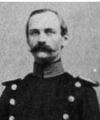Caesar Riistow
Caesar Riistow (born June 18, 1826 in Brandenburg an der Havel , † July 4, 1866 in Dermbach ) was a military writer and Prussian officer . He was the brother of Wilhelm Rustow and Alexander Rustow the Elder. Ä. as well as grandfather of Alexander Rustow .
Life
After he was educated in the Cadet Corps , Riistow came in 1843 as an officer in the 32nd Infantry Regiment in Erfurt . In 1849 he was sent to Suhl to supervise Prussian rifle production , where on October 9, 1851 he married Emilie Frederike Johanna Spangenberg, the daughter of a gun dealer from Suhl. With her he had two sons and a daughter. However, his wife died of tuberculosis on June 30, 1859 at the age of only 28 , so that the children grew up with their grandmother.
During the inspections, Riistow dealt more and more with rifle technology, which has undergone several revolutionary technical innovations in these decades. In addition to the needle rifle , with which the rate of fire was significantly increased, the Minié rifle was developed , favored by Rüstow. During the Crimean War , the Prussians changed 300,000 muzzle-loaders according to Minié's system within 18 months . He became chairman of the Royal Prussian Rifle Acceptance Commission in Suhl.
During the peak of the economy of the Minié rifle, Rüstow quickly advanced to become a profound expert on this system. He put his findings down in 1855 in the publication Das Miniégewehr . Riistow became a teacher at the Prussian division school, later a teacher at the war school in Erfurt . In 1857 another treatise on the Minié rifle with the title Retrospectives on Prussia's rifle modification according to the Minié system was published without mentioning his name . His main work, however, was Die Kriegfeuerwaffen , which also appeared in two volumes in 1857. The first volume dealt with the structure of the weapons and has even been officially translated into Russian . The second volume dealt with the individual types of weapons and their properties, which differ according to the war purpose.
In 1862 Caesar Riistow was a general staff officer in the 1st Division in Königsberg . Four years later he was promoted to major in the 15th Infantry Regiment . With this he took in the division " Goeben on" campaign part of the Main Army. When he was leading his battalion in the battle of Dermbach , a Bavarian bullet hit him in the abdomen on July 4, 1866. At the first aid station, a second in the back of his head put an immediate end to his life. Caesar Rustow was buried together with a fallen Bavarian general in Geisa in the Rhön. His grave monument is now in the Geisa cemetery.
Works
- Guide to weapons theory. Erfurt 1855 (Reprint: Edited by Anton FW Sommer. Anton Sommer, Vienna 2006, ISBN 3-902539-40-2 . ( Military historical series 3))
- The minié rifle and its importance for war use. Berlin 1855 (Unchanged reprint: Intersico-Press, Zurich 1976. ( Morion-Reprints 10))
- Review of Prussia's change to the rifle according to the Minieschem system. Erfurt 1857, (Unchanged reprint in: Das Miniergewehr ... Intersico-Press, Zurich 1976, ( Morion-Reprints 10))
- The handguns of war. Berlin 1857–1864, 2 volumes.
- The newer rifled infantry rifles. Your true efficiency and the means to ensure it. 2nd edition, Verlag Zernin, Darmstadt 1862.
literature
- Meyer's Lexicon. Volume 17. Bibliographical Institute, Leipzig Vienna 1896, p. 313.
- Bernhard von Poten : Rustow . In: Allgemeine Deutsche Biographie (ADB). Volume 30, Duncker & Humblot, Leipzig 1890, pp. 34-38. - (one of the three brothers)
- Theodor Fontane : The campaign in Bohemia and Moravia 1866. Königl. Secret Ober-Hofbuchdruckerei R. v. Decker , Berlin, 1871 (new edition: Verlag Rockstuhl, Bad Langensalza 2001, ISBN 3-934748-75-9 ).
- Reporter from home. The campaign of the Prussian Main Army in summer 1866. Velhagen & Klasing, Bielefeld and Leipzig 1867. pp. 112–115.
- Stefan Arend : A remarkable tomb in the Geisa cemetery. Memories of the German-German war of 1866. In: Rhönwacht No. 2/1998, p. 70.
Web links
| personal data | |
|---|---|
| SURNAME | Riistow, Caesar |
| ALTERNATIVE NAMES | Riistow, Caesar |
| BRIEF DESCRIPTION | Prussian military writer |
| DATE OF BIRTH | June 18, 1826 |
| PLACE OF BIRTH | Brandenburg |
| DATE OF DEATH | 4th July 1866 |
| Place of death | Dermbach |


